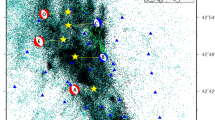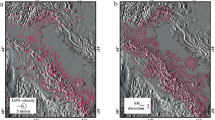Abstract
Two central problems in seismology are the location of earthquake epicentres and the allocation of magnitudes to earthquakes. We show in this communication that these problems can be reduced to the classic statistical model of two-way analysis of variance. Applying this theory to the reduction of pooled data from many stations and earthquakes leads to estimation of source and station terms and the interaction between them. In particular, it provides the theoretical framework for the method of group (or regional) adjustment of epicentres used by Freedman1 and Douglas2. The embedding of the problems in this theory opens the way for strict statistical tests of various hypotheses of geological interest.
This is a preview of subscription content, access via your institution
Access options
Subscribe to this journal
Receive 51 print issues and online access
$199.00 per year
only $3.90 per issue
Buy this article
- Purchase on SpringerLink
- Instant access to full article PDF
Prices may be subject to local taxes which are calculated during checkout
Similar content being viewed by others
References
Freedman, H. W., Bull. Seism. Soc. Amer., 57, 545 (1967).
Douglas, A., Nature, 215, 47 (1967).
Freedman, H. W., Bull. Seism. Soc. Amer. 56, 677 (1966).
Bolt, B. A., and Nuttli, O., J. Geophys. Res., 71, 24 (1966).
Jeffreys, H., Bur. Cen. Seism., Inter. A., Trav. Sci., No. 14, 3 (1936).
Scheffé, Henry, in The Analysis of Variance (Wiley, New York, 1959).
Gutenberg, B., and Richter, C. F., Ann. Geofisica, 9, 1 (1956).
Carpenter, E. W., Marshall, P. D., and Douglas, A., Geophys. J. Roy. Astro. Soc., 13, 61 (1967).
Author information
Authors and Affiliations
Rights and permissions
About this article
Cite this article
BOLT, B., FREEDMAN, H. Group Analysis of Variance for Earthquake Location and Magnitude. Nature 217, 47–48 (1968). https://doi.org/10.1038/217047a0
Received:
Issue date:
DOI: https://doi.org/10.1038/217047a0



